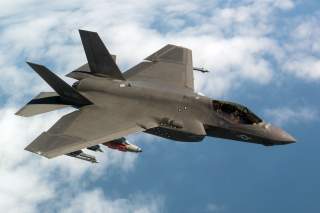Ready for War?: Lockheed Martin Is Celebrating the F-35's Last Flight Test
Or not?
Lockheed Martin is celebrating the F-35’s last flight test for the Joint Strike Fighter program’s System Development and Demonstration (SDD) phase.
This last flight test marks the beginning of the end of the SDD phase, which started 2001 when Lockheed’s X-35 prototypes triumphed over Boeing’s ungainly X-32 concept aircraft after a hotly contested fly-off. Moreover, this last sortie marks end of a flight test program that first started in 2006 when the first F-35A test article (AA-1) took to the sky.
“Completing F-35 SDD flight test is the culmination of years of hard work and dedication from the joint government and industry team,” Vice Adm. Mat Winter, F-35 Program Executive Officer, said in a statement. “Since the first flight of AA-1 in 2006, the developmental flight test program has operated for more than 11 years mishap-free, conducting more than 9,200 sorties, accumulating over 17,000 flight hours, and executing more than 65,000 test points to verify the design, durability, software, sensors, weapons capability and performance for all three F-35 variants. Congratulations to our F-35 Test Team and the broader F-35 Enterprise for delivering this new powerful and decisive capability to the warfighter.”
Recommended: The Story of the F-52 Fighter.
Recommended: The 5 Biggest Nuclear Bomb Tests (From All 6 Nuclear Powers).
Recommended: How Israel Takes U.S. Weapons and Makes Them Better.
Lockheed Martin is understandably proud of finally completing a key portion of what is the most complicated and difficult combat aircraft development program in aviation history. “The F-35 flight test program represents the most comprehensive, rigorous and the safest developmental flight test program in aviation history,” Greg Ulmer, Lockheed Martin’s vice president and general manager of the F-35 program, said. “The joint government and industry team demonstrated exceptional collaboration and expertise, and the results have given the men and women who fly the F-35 great confidence in its transformational capability.”
According to Lockheed, the final SDD flight happened on April 11, 2018 at Naval Air Station Patuxent River in southern Maryland when a Navy test aircraft called CF-2—flown by test pilot Peter Wilson —completed a mission to collect loads data while carrying external 2,000-pound GBU-31 Joint Direct Attack Munitions (JDAM) and AIM-9X Sidewinder heat-seeking missiles.
During the totality of the flight test program, the F-35 test team conducted six at-sea detachments and performed more than 1,500 vertical landing tests on the F-35B variant. The F-35 test program also completed 183 Weapon Separation Tests; 46 Weapons Delivery Accuracy tests; 33 Mission Effectiveness tests, which included numerous multi-ship missions of up to eight F-35s against advanced threats. “From flight sciences to mission systems testing, the critical work completed by F-35 test teams cleared the way for the Block 3F capability to be delivered to the operational warfighter,” Lockheed said in a statement.
The SDD phase will formally come to a close following the F-35’s successful completion of Operational Test and Evaluation and a Pentagon decision to go into full-rate aircraft production. However, F-35 flight-testing will not end there.
“While SDD required flight test is now complete, F-35 flight testing continues in support of phased capability improvements and modernization of the F-35 air system,” Lockheed said. “This effort is part of the Joint Program Office’s Continuous Capability Development and Delivery (C2D2) framework, which will provide timely, affordable incremental warfighting capability improvements to maintain joint air dominance against evolving threats to the United States and its allies.”
Indeed, flight testing—as is the case for all military aircraft—will continue throughout the service life of the F-35, which could continue past 2070.
Dave Majumdar is the defense editor for The National Interest. You can follow him on Twitter: @davemajumdar.
Image: Creative Commons

